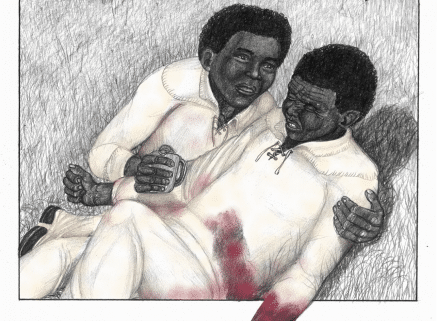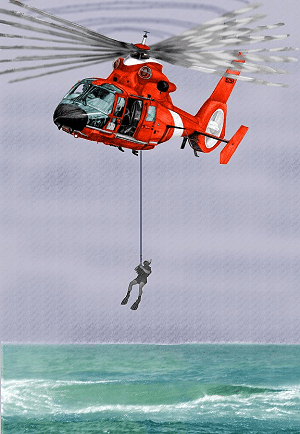Okay… I changed my relationship with WordPress, and things have not come out, yet, as I had hoped. I hope to return to https://mjarts.blog
01/20/19
CPO John Seidman was my wife’s nephew; he died in a failed Coast Guard rescue in October of 2009…a tragic accident.
Members of the US Coast Guard have a special place in my heart.
Today, the spouses of members of the US Coast Guard are figuring out where they will get their family’s next meal because members of the Coast Guard are working without pay, due to heartless politicians who have forced the country into a Shutdown. Legislation in Congress to stop the Shutdown has already been passed, Legislation that will allow the Shutdown to end; but these approvals are not being passed on to the President for his signature, or his veto of the Legislation; a veto which can be overridden by the two Houses of the Legislative Branch. The Shutdown can end today, if certain people will swallow their pride and do their duty to Serve. As do those Federal workers you and I employ to serve us.
You can support Furloughed Federal Government workers by donating to your local Food Bank:
https://www.feedingamerica.org/find-your-local-foodbank

First Heroes For Freedom, Silver Moon Press, Spring 2000
Physical Pain.
It started in a PE class in high school. I was on a trampoline, with the goal of jumping upwards and landing on the lower part of my chest; what actually happened is that I landed on the upper part of my chest, causing my legs to fly over and behind my head: Э I heard my spine pop like my desk chair rolling over the bubble wrap on my office floor [I am by nature untidy]; for the next few weeks, when I turned to face someone, I rotated my body like a door on hinges. My parents probably did not have health insurance, and it seemed like, if you could get to a doctor, you didn’t really need one. From that point onward, I lived with continual pain in my low back, and recurring sciatica—burning pain in the outer part of my thighs from damage to the Sciatic nerve.
There was a significant amount of time when the pain stopped. My fiancée and I went to a crusade here in Portland; some evangelist whose name I forgot. The first evening contained some profound teaching on the subject of Faith; the second or third evening, he was ‘giving out the Gift of Tongues’—glossolalia. Glossolalia is found in a variety of religious experiences—speaking in unknown languages. The Apostle Paul, in the New Testament, refers to ‘speaking in the tongues of angels’—and most importantly, if there is no one around to interpret this language, when spoken in public, it has no value. Glossolalia runs counter to my personality; but I felt compelled to go down to that stage…where I found myself lying on the floor, with babbling people rubbing their hands over me. After a few minutes, I asked the Creator if I could go back to my seat; the experience was getting embarrassing. On my way back to my seat, some gal with a clipboard asked me if I had ‘received the Gift of Tongues’ and looked confused when I said that I hadn’t. A day or two later, I realized that my back didn’t hurt—first time in years—when one deals with chronic pain, it tends to have a habitual aspect—I expected to be in pain, ‘so I was’. My awareness of ‘no-pain’ wasn’t immediate.
One more experience of Unexplainable Happenings in my life. Things for which I cannot find a logical explanation; things that seem to be a result of an act of faith. I cannot articulate ‘why’ the Creator would intervene in my life; nor can I predict when such things might occur. I know a guy who has heard voices that directed him out of events that would have cost his life. I’ve never heard voices; but I have ‘sensed’ that I was supposed to do things. These events add some weight to the results of my inner mental wanderings.
Three totaled cars, years working as a carpenter—the back pain came back. The reality is that I now have two stenoses in my spinal column. Damaged vertebrae and a narrowing of the hole through which the spinal nerve pass. I don’t know if the damage occurred in high school or is caused by some other deterioration. There are no past records I can check.
Some good news is that I don’t feel Sciatic pain any more—those nerves are damaged by my ‘idiopathic polyneuropathy’—doctorspeak for ‘your nerves are messed up, and we don’t know why’. The reality is that Neurology is still in its ‘childhood’—Neurologists don’t know nearly as much as they pretend to. My understanding is that most neurological conditions have no label because the nervous system isn’t very well understood.
What appears to be occurring is that my nerves’ outer sheathing/protection is deteriorating. I liken it to wiring with its insulation damaged. If you connect the exposed wiring to something that conducts electricity, you get a short circuit. At the same time I have this growing superpower of being impervious to external pain/sensation, I also have my own Kryptonite; my damaged nerves provide a burning pain of their own, which never stops. Diminished by medication.
We each have the option of choosing our own self-identification; while I deal with constant pain, I work at not letting it become my self-definition. I believe in possibilities; my Faith tells me that Pain won’t be my self-definition when I end my journey here on this world.
Enough of that.

Promotional image for the Man of Steel
I decided, when I started this blog, that I wasn’t going to write anything, in terms of working as an illustrator, that wasn’t accurate. Consequently, I haven’t written a lot about being a freelance commercial artist. I know a lot of things that don’t seem to work very well. As a freelance commercial artist, I’ve wasted a lot of money on print advertising, I’ve wasted a lot of money on digital advertising and a lot of time trolling Craigslist. Most of my income, for the last twenty years, has come from my other business—Building Code consulting. The enjoyable part of that business is that I always need illustrations to explain Building Code concepts; and I have this in-house illustrator who makes my technical writing more understandable. I bill him out at an hourly rate.
I cannot tell you how to become successful as a freelance commercial artist.
I create images that people admire, but don’t particularly want to buy. When I started this gig—having been told by my doctor that I needed to change careers in order to keep my health—I collected a folder full of images that I admired. I mostly focused on ‘the Golden Age of Illustration’ plus other examples of realism that border on fine art. I invested something like ten years into being able to create the kind of image I want to produce, consistently. In those ten years the world of illustration changed. Illustrations for children’s books became cartoony and photographers became illustrators.
A reality that I do not like to admit is that as in the rest of my life, I am a dinosaur; and I have no desire to change what I do. Refer to my last post, with Illustration Tip #1.
- Illustration Tip #2:
Portfolios, digital and otherwise: back in the days when dinosaurs ruled the earth, all advertising was done on paper. Color made of ink-on-paper can be very different from color-made-from-light. Not only is it important to set the ‘gamma’ of a monitor [yes, even today], it is important to know what sort of color setting [Printer Profile] the printer is using. Print images use CMYK [Cyan, Magenta, Yellow, black] inks and monitor images and photocopiers use RGB [Red, Green, Blue] toners and diodes.

First Postcard | Second Postcard | Third Postcard
Hire an Illustrator is a company in the UK who hosts one of my portfolios and sends out postcards to art buyers. The first time I sent them a card design, I neglected to find out what Printer Profile they use. The second card was better [too much green] and the third was tolerable [the other side is too dark, but tolerable].
Does this sort of advertising work? My usual measurement for ‘working’ is whether or not I’ve gotten an inquiry or work as a result of the advertising. I’ve gotten work through this vendor, so I keep using them [beside which, I like the people].
- Illustration Tip #3:
If you are going to use online advertising via digital portfolios, you will need to provide the vendor with a title, a description of the work, and Keywords to locate your work on their website:
Third Postcard, above:
Doctor Who at Rainbow Canyon
fan art; promotional image, Digitally-colored graphite drawing, digital manipulation
Keywords: Fantasy, Children, People, Realistic, Children's Book, Comic Book Art, the Doctor, TARDIS, Dr-Who, whovian, doctorwho
I keep a Keywords.txt file in my Windows-based office network, for every image I post online. Setting up illustrations for a new-to-me vendor is very tedious. I assume that Apple has some sort of equivalent to a text file.
- Illustration Tip #4:
As an editorial note regarding Windows:
![]()
That grey rectangle after the colon: is not simply a blank space. In that space are all sorts of instructions for Windows in terms of font, spacing, and a bunch of other stuff. When you transfer the words in that box to some other format, such as WordPress in their new iteration, the phrase is messed up. The same thing happens from transferring Word to html and other machine languages. It’s best to do your copy and paste from a text file, which has no hidden attributes.
This can become a problem when creating a digital book through Amazon or some other vendor. If you attempt to create a digital book using a Word manuscript, you will encounter strange things within the text—that information in the grey rectangle. When I create digital books, I use Adobe InDesign- there are no grey rectangles. More tedious; better results.





